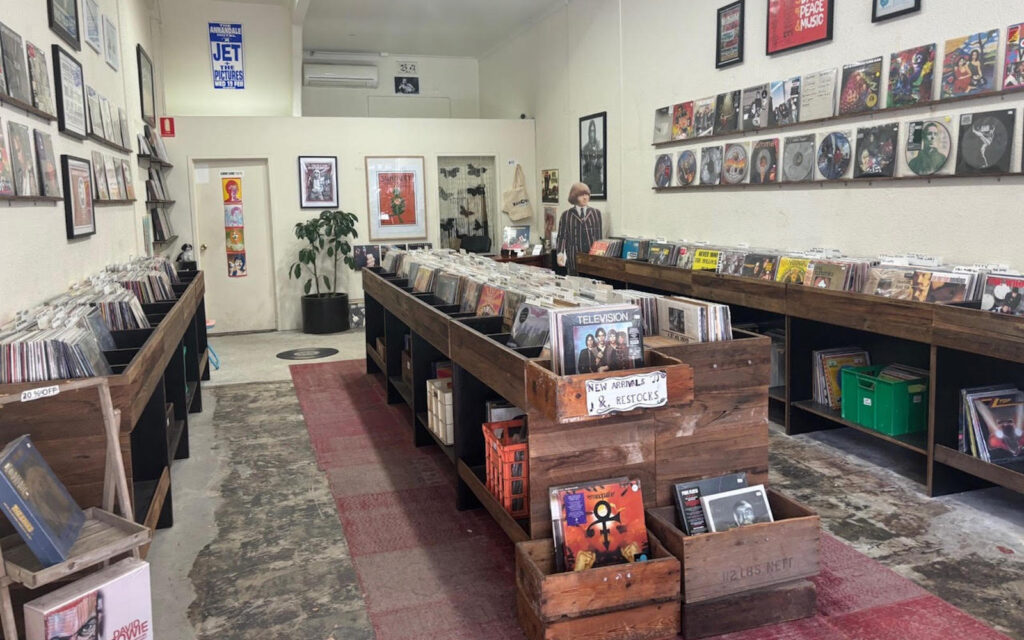“With I’m In Your Mind Fuzz we had the idea of making the record kind of like one long song and having all the songs run into each other, and having themes which came in and out, and having it like being chapters of one big track,” Mackenzie says. “But I think we ran out of patience or motivation. I guess we wrote some songs that we felt should be on that record but didn’t completely work with that concept.”
The bones of Nonagon Infinity would lie bare for the next 18 months while King Gizzard diverted their attentions to the quadratic psychedelic assembly of Quarters! and the folk-acoustic wandering of Paper Mache Dream Balloon. “Quarters! and Paper Mache were distractions from Nonagon while we were working on it, while we were telling ourselves, ‘No, it’s not ready, we need more time, we need to keep playing the songs live, it’s not ready yet.’ So this record was definitely a slow burner.”
While it’s a strain to remember what was on the turntable at the time the album was conceived, Mackenzie can recall, “being on a massive Hawkwind binge”, as well dipping into some ’70s Turkish psychedelia.
“There was also some more heavier stuff than we’ve listened to before,” he says. “We did want to make this the heaviest record we’d made before – that was one of the things we were trying to tie it up with.”
Structurally, Nonagon Infinity was about having a single musical concept that could broken down into modular elements. “We wanted to experiment with different time signatures – we wanted every song to be an experiment in its own way, but we wanted them to be all linked and not only flow on from each other but to reference each other so that it’s more of one track than it is separate tracks. But at the same time we wanted it to be somehow listenable as nine separate chapters, which as an individual piece makes sense and goes from A to B.”
The notion of having a single organising idea for a record has always seemed part of King Gizzard’s modus operandi, whether it’s a thematic element, or the repeated presence of a melodic refrain.
“I think we’ve always done that,” Mackenzie says, “whether it’s heavier, whether it’s acoustic or there’s a certain feeling, or with Quarters! the songs were supposed to be simpler and repetitive on purpose, or kind of boring on purpose. Maybe it’s just me personally, but I like to know the destination before we set off on the journey. Some people will say that songs just pop out of their heads, or they can’t choose what they’re writing, they just follow their emotional path, but I’m not that person.”
Mackenzie compares King Gizzard’s creative process to that of construction work. “You’re building something,” he says. Random ideas can be the source of artistic inspiration, but what might appear to be chaotic has an underlying pattern.
“Creation can be black and white, creation doesn’t have to be this miracle spark, like your brain is this magic power that spews forth randomness. I think there’s an element of that, and your brain definitely does spew forth randomness, but if you can organise the chaos I think you can get from A to B more easily – at least I can. But for us there’s always been the destination not the journey, I suppose.”
Mackenzie sees himself as the producer or director of the King Gizzard project, but he didn’t assume the role of artistic dictator on Nonagon Infinity. “Everyone in the band has their own places to put their creative ideas if they need to. I’m lucky that there’s a bunch of super creative people involved who are all capable of doing their own thing. It’s always been different for different records – for Nonagon this was one that I did take over. All the ideas were mine but a lot of them were like a very vague melodic refrain or something, or vague feel or groove. [Then I’d say], ‘Everyone go nuts, now see what happens.’ A lot of this record was that – it was very free.”
Mackenzie concedes that Nonagon Infinity’s long gestation period has led to an element of fatigue. “I think I’m a lot more tired of Nonagon Infinity that anything else at the moment, because it’s been so present for so long, and I’ve spent so many hours working on so many elements of that record that just listening to it again is killing me. But I don’t often do that. Some people will probably look back on their past things they worked on and feel that maybe they could have done better or something, but I suppose over the years rather than trying to better ourselves we’ve tried to do something different.”
BY PATRICK EMERY







